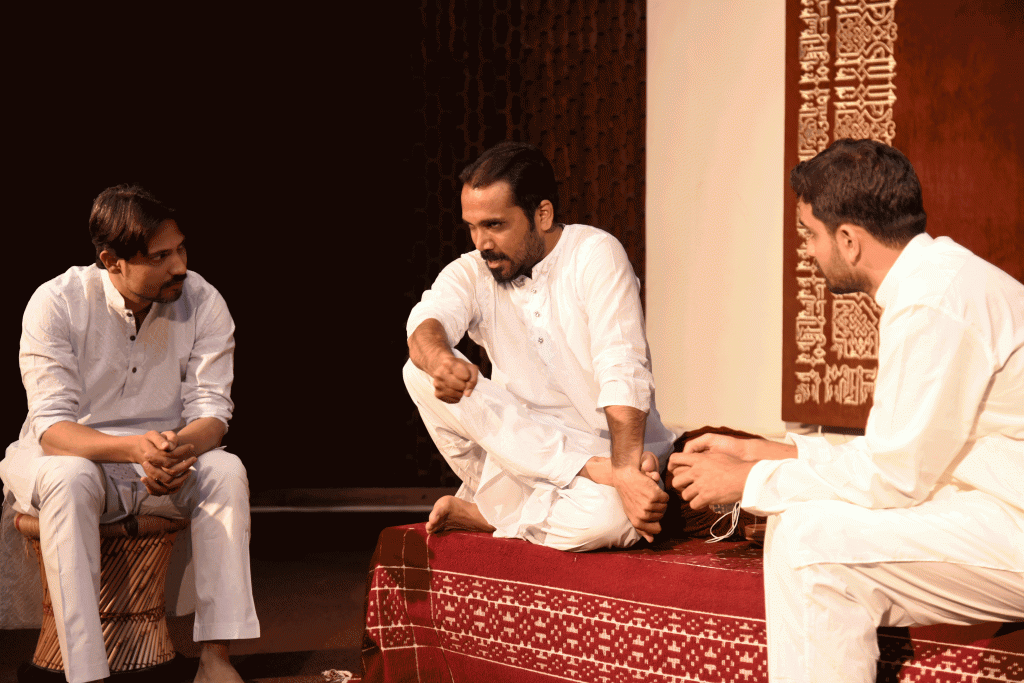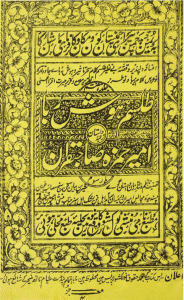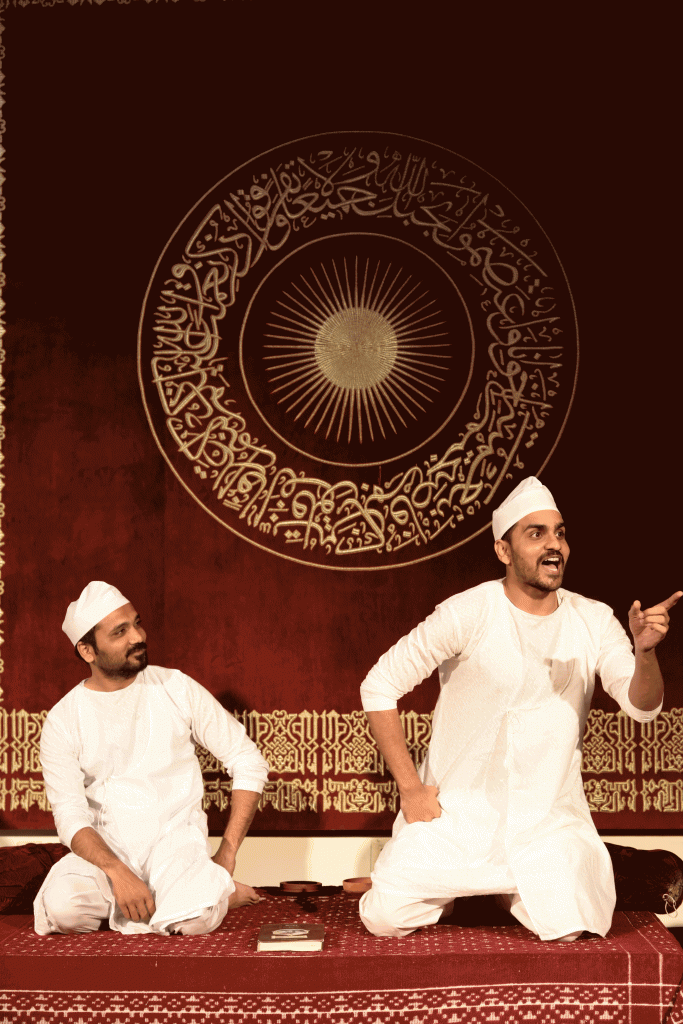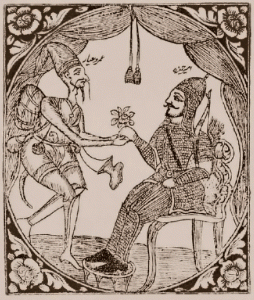Dastangoi: Revival of an ancient art form.
By Ally Adnan | Arts & Culture | Theatre | Published 9 years ago
Graduates of the National Academy of Performing Arts (NAPA), and students of the revered Zia Mohyeddin, Nazrul Hassan, Fawad Khan and Syed Meesam Naqvi, are the leading proponents of dastangoi in Pakistan. In an exclusive interview with Newsline, the three young thespians talk to Ally Adnan about the history, evolution and revival of dastangoi, their work in the field, and the elements of the art form.
Fawad Khan: Dastangoi is the oral tradition of storytelling. The word itself is a compound of two Persian words, dastan and goi, and means telling a story. A dastan may be written over years, created overnight, or composed by combining existing stories but it is always crafted to be told orally in a series of sittings. A novel is written to be read, a play is written to be performed and a dastan is written to be told to a live audience. Dastangoi does have elements of theatre, and sometimes those of singing and other performing arts as well, but it is essentially the art of telling stories orally.
How do you define dastan?
Fawad Khan: A dastan is a long, expansive and elaborate tale that tells numerous interlinked stories of heroism, romance, magic and adventure, incorporating both prose and poetry. It is rendered orally and has four essential elements: razm (battle), bazm (soirees), sahiri (magic), and ayyari (trickery).
Nazrul Hassan: The four elements are not really woven into the story but form the structure upon which a dastan is constructed. Principally, the stories do not have any cultural, political, religious or intellectual purpose. The goal is to celebrate the art of storytelling by narrating interesting, fantastic stories expertly and holding the attention, interest and curiosity of the listeners for extended periods of time. A successful session of dastangoi always had listeners asking, phir kya hua (what happened next)?
What is the difference between a dastan and a qissa?
Nazrul Hassan: Dastan and qissa, both mean ‘story,’ linguistically, and are traditional narrative forms. There is little distinction between them today but the two genres are, in fact, different. Dastan has Persian roots whereas qissa has Arabian roots. A dastan is typically longer than a qissa and, in fact, consists of several qissas. A dastan must always have the four essential elements that Fawad mentioned but it is not necessary for a qissa to have those elements. Most importantly, a dastan is crafted specifically for narration, whereas this is not always true for a qissa.
What is the history of the dastan?
Syed Meesam Naqvi: The genre of dastan originated in medieval Persia. Folk story-tellers contributed to the evolution, development, spread and popularity of the genre. The dastan came to the Indian subcontinent with the arrival of rulers who spoke Persian, and included dastangos (professional story-tellers) in their entourages. The story-tellers practiced their art in courts, in private soirees and at public gatherings. Over time, the genre became very popular in the region and came to be practiced in many languages and not just in Persian. It was at its peak in the nineteenth century.
The story of Amir Hamza has always dominated the world of dastan. Why is that so?
Syed Meesam Naqvi: Persian storytellers brought a lot of interesting dastans to the subcontinent, but the story of Amir Hamza was the one that found lasting popularity in the region. It has a valiant hero as the central character. The villains are devious and the females enchanting. The 18-year period that Amir Hamza spends amongst deos (demons), jinns (djinns) and parees (fairies) in the land of Qaaf adds an enchanting element of fantasy to the tale. Finally, the story has a satisfying and clear resolution. The oral tradition of telling the Amir Hamza story can be traced back to the fifteenth century — and according to some scholars, the eleventh — in the region.
How was Indian cinema influenced by the dastan?
Fawad Khan: Brave heroes, beautiful heroines, devious vixens, funny young men and wicked villains, who have always been staple characters in dastans, are ubiquitous in Indian films. The battle between good and evil, and the eventual triumph of the righteous, has been the subject of a large number of films.
Nazrul Hassan: It is tempting, and convenient to exaggerate the influence of dastan on cinema because a lot of the elements Fawad mentioned are also found in ancient Hindustani theatre as far back as the third century. The subject merits serious study and research but the truth may never be known. Intezar Hussain Sahib famously said, “kahaniyan awara hoti hain (stories are bohemian).” It is almost impossible to determine their roots.
How did the oral tradition of dastan transform into printed work?
Nazrul Hassan: The dastan was very popular in the nineteenth century and a number of people felt that the stories would work well in printed form. The goal was to preserve the tradition and to cash in on its popularity. Fort William College, Calcutta, published the story of Amir Hamza in Urdu at the beginning of the nineteenth century. In 1881, Munshi Nawal Kishore founded the famous Lucknow Press and started publishing dastans. In 1881, he employed the services of three dastangos, Muhammad Husain Jah, Ahmed Hussain Qamar and Sheikh Tasadduq Hussain, to work on transcribing the complete stories of Amir Hamza. The result was a set of 46 books that was published in the early twentieth century.
Does the dastan have a social, cultural or religious purpose?
Fawad Khan: I may get into trouble with some scholars but I believe that the dastans have never had a social or religious purpose. They were a part of our cultural fabric for a very long time. Indeed, a lot of cultural values that we hold dear today were demonstrated and promoted in dastans. The goal of the dastan has always been to entertain listeners by transporting them to a fantastic world inhabited by valiant heroes, beautiful princesses, lovely fairies, wicked magicians, clever villains and alluring ladies. The attention, interest and engagement of listeners — and no social or religious purpose — sustained the dastan. The heroes were Muslim and they fought the kufaar (infidels), but these were not Islamic wars. They represented the fight between good and evil.
The dastans, thankfully, do not feature fundamentalist Islam. In fact, they depict a very unorthodox form of Islam.
 Fawad Khan: They sure do. Muslim men in dastans like to drink, listen to music, enjoy sex, appreciate dance and spend a lot of time in the company of beautiful women.
Fawad Khan: They sure do. Muslim men in dastans like to drink, listen to music, enjoy sex, appreciate dance and spend a lot of time in the company of beautiful women.
A few passages in some dastans are excruciatingly detailed in their description of sexual encounters. In one hilarious encounter, the Muslim hero exclaims, “kafir jadugarni ko Islam qabool karna ho ga (the infidel enchantress will have to accept Islam),” just before copulating because he cannot have sex with a non-Muslim.
A few dastangos claim to have promoted Islam in their dastans.
Fawad Khan: Yes, they do, but the claims are hollow. They made such claims to promote their dastans.
The dastan has been criticised for the sexual objectification of women. Is the criticism fair?
Syed Meesam Naqvi: It is true that, more often than not, women are objectified in dastans but the criticism cannot and should not be used to dismiss one of our most important art forms. Yes, women are portrayed as beautiful, attractive and subservient to men in dastans but there are dastans where female characters are capable, fearless and intelligent. In Tilism-e-Hosh Ruba, Mahrukh leads a battalion of soldiers, shoulder to shoulder with men, and prevails. She is a brave woman with a lot of substance.
It is easy to make accusations of sexism but the topic requires serious study and scrutiny. Beauty and wisdom in females are not mutually exclusive. A woman can be both very good-looking and very intelligent. One must also look at sexism in any story in the context of the sensibilities of the time when the story was originally told.
There is rampant objectification of women in the Mahabharata. Does that mean one should criticise and dismiss the Sanskrit epic? Shakespeare objectifies women in the Taming of the Shrew and engineers an end where patriarchy prevails. Does that make Shakespeare’s comedy unimportant? The narrator of Alif Laila (A Thousand and One Nights), Scheherazade, is female but the stories she tells often objectify women. So, yes, women are objectified in dastans but declaring the form sexist and dismissing it is irresponsible, reckless and unfair.
 Nazrul Hassan: A dastan is certainly not an Ibsen play but it is not an essentially escapist genre either. It is an accurate, often very detailed, reflection of the culture, society and values of a time in history. It may have some elements of escapism — and that is fine — but, for the enlightened and initiated listener, it does allow an opportunity to study the moral, social and cultural fabric of the time and region in which it is set.
Nazrul Hassan: A dastan is certainly not an Ibsen play but it is not an essentially escapist genre either. It is an accurate, often very detailed, reflection of the culture, society and values of a time in history. It may have some elements of escapism — and that is fine — but, for the enlightened and initiated listener, it does allow an opportunity to study the moral, social and cultural fabric of the time and region in which it is set.
The first Mughal Emperor, Babar, described the Hamzanama as “one long far-fetched lie, opposed to sense and nature.” His grandson, Akbar, fortunately enjoyed the dastan and commissioned a momentous illustrated manuscript that took 14 years to complete.
Was Babar wrong in his description of Hamzanama?
Fawad Khan: It is a matter of personal taste. I believe he was wrong.
Syed Meesam Naqvi: After reading a number of dastans, I can say, “kahani aisi jhooti bhi nahin, baat aisi meethi bhi nahin (the story is not that full of lies, the subject is not that sweet either).”
Was dastangoi originally a form of entertainment reserved just for the aristocrats, or did commoners have access to it as well?
Syed Meesam Naqvi: No. There was never a period in time when the dastan was reserved exclusively for royalty and nobility. It was originally a folk tradition available to everyone. Dastangos used to tell stories on the stairs of Jamia Masjid. Coffee Houses in Iran were known for dastangoi sessions. Travelling storytellers narrated dastans to commoners in parks and on street corners. The dastan is not tainted by the elitism that is seen so often in other art forms.
Which dastans are considered to be the best representatives of the genre, and why?
Fawad Khan: I would say that Dastan-e-Amir Hamza is the best representative of the genre.
Does the florid — and now archaic — language add to the charm of dastans or does it make the art form more esoteric?
Syed Meesam Naqvi: The language of the dastan is the genre’s biggest strength. It makes the dastan charming, attractive and enjoyable. A dastan that lacks in latafat-e-zaban and fasahat-e-bayan is not a dastan at all. The magic is in the language. The language used by Shakespeare is archaic but that does not make his works esoteric. The same is true for the dastan.
What is the reason behind the recent increase in the popularity of dastangoi, both in India and in Pakistan?
Syed Meesam Naqvi: I think the main reason is the beauty of the language of the dastan. The finest example of language can be found in the dastan; no other genre comes close. Every single sentence in a dastan is meaningful, well-constructed and musical. The use of the metaphor and simile is amazing. Qualifications are florid and descriptions elaborate. Dastan is poetry in prose. I think people are fascinated by the language of the dastan.
Dastangoi was at its peak at the turn of the nineteenth century and is said to have died with the death of its last great practitioner, Mir Baqar Ali, Delhi in 1928. The oral tradition has seen a revival in recent years, but current-day dastangoi does not have verifiable links to the original form.
Is this, then, more a re-invention than a revival of dastangoi?
Nazrul Hassan: It can be said that it is re-invention because very little documentation is available about the style, tenor and craft of the original dastangos. A single audio recording of Mir Baqar Ali is available, but it is brief and not of good quality. It does not shed much light on the topic. It can, however, be said with certainty that the original dastangos had great command over language, tremendous histrionic ability and a very productive imagination. Capable dastangos of our time embody those very characteristics.
Is dastangoi a part of Islamic or South Asian culture?
Syed Meesam Naqvi: South Asian culture.
The Harry Potter series of seven novels by British author J. K. Rowling appears to meet all the fundamental requirements of the genre. Is it a dastan?
Fawad Khan: Not really. It does have the elements and constituents of a dastan but it was written to be read and not narrated. Ergo, it is not a dastan.
 Does it bother you that Pakistani youth today is far more familiar with Harry Potter than with Amir Hamza?
Does it bother you that Pakistani youth today is far more familiar with Harry Potter than with Amir Hamza?
Fawad Khan: It bothers me. In fact, it makes me angry but I find it very difficult to blame our youth. Parents, teachers, the media, and the government need to promote our own culture so that Pakistani youth becomes acquainted with the rich cultural traditions of the region.
Can dastans be made into compelling films with the reach, expanse and scale of, say, the Harry Potter movies?
Fawad Khan: In the hands of the right filmmakers, and with sufficient budgets, tremendous films can be made using our dastans as the base.
The three of you are professionally trained actors. Does the training help you in dastangoi?
Nazrul Hassan: Yes, it does. As professional actors, we don’t have stage fright and are comfortable in front of live audiences. We know how to project our voices. We know the techniques used to get into the character. And, most importantly, we have learnt how to memorise long sections of text.
One of the attributes of good dastangos used to be their ability to improvise, expand and modify stories, on the fly, based on the taste, mood and interest of their listeners. You have painstakingly memorised rather long passages of famous dastans. Does the effort, albeit commendable, limit your ability to improvise, create and extemporise during dastangoi sessions?
Syed Meesam Naqvi: Yes, we are limited in our ability to improvise, create and extemporise during dastangoi sessions because we try to preserve the integrity of the text. The language of dastans is very ornate and elaborate. It is not easy to extemporise and maintain the quality of language at the same time during a dastangoi session. We do add a word, or a sentence, here and there, every now and then, but extensive extemporisation is out of the realm of our abilities at this time. Fortunately, we are students and still learning. We will get there one day.
A career in show business has recently become a viable one in Pakistan. Do dastangos, like actors, do well financially?
Fawad Khan: The money that is flooding the world of show business in Pakistan today has not yet made its way to dastangos.
Syed Meesam Naqvi: It is not possible to have a viable career in dastangoi in Pakistan today. A dastango needs to do more than just dastangoi to make both ends meet.
The three of us are variously involved in acting, directing and work in the theatre, cinema and television.
The legendary Urdu scholar Shamsur Rahman Faruqi and his nephew, writer and director Mahmood Faruqi, played significant roles in the revival of dastan in India. Do you feel that the three of you have done similarly laudable work in Pakistan?
Fawad Khan: It is not even flattering to be compared to Shamsur Rahman Faruqi and his nephew; it is embarrassing. Shamsur Rahman Faruqi is a great scholar who has done monumental work in the field of dastan. Anyone who wants to learn about dastan, needs to study his works.




